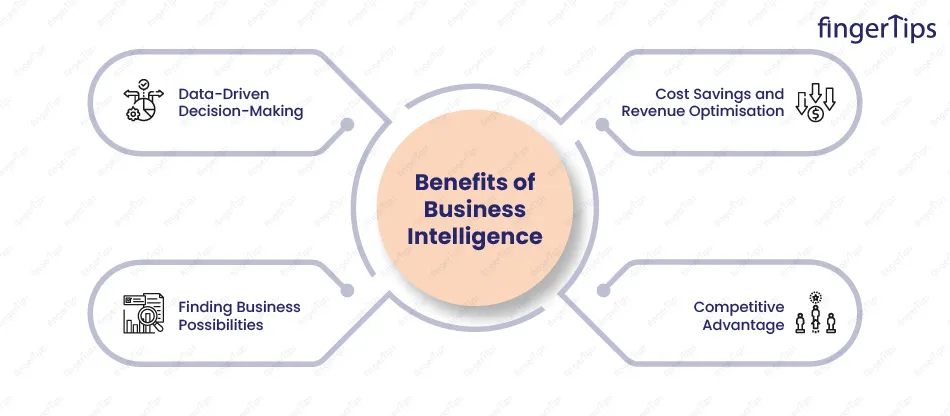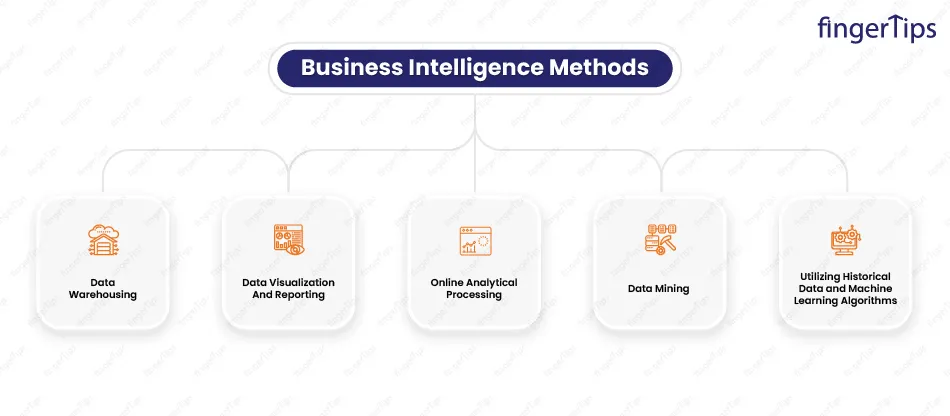What Is Business Intelligence?
Business Intelligence (BI) is the process of obtaining, analyzing, and transforming raw data into meaningful insights to support data-driven decision-making in organizations. It involves data extraction, consolidation, and visualization from various sources using different tools and technologies. BI provides a comprehensive understanding of an organization's performance through reports, dashboards, and visualizations that are easy to comprehend. The ability to recognize trends, patterns, and opportunities, as well as potential dangers and problems, is provided by these insights to stakeholders, including executives, managers, and analysts.
Business intelligence's main objectives are to boost organizational performance, streamline processes, and stimulate strategic planning. Organizations can enhance efficiency, increase revenue, decrease expenses, and gain a competitive advantage in the market by accessing historical and real-time data.
Data integration, data warehousing, data mining, data visualization, and data analytics are only a few of the many tasks covered by business intelligence (BI). It enables users to access and comprehend data at all organizational levels, establishing a data-driven culture that supports improved decision-making and hastens the expansion of businesses.
Business Intelligence Vs. Business Analytics
Business Analytics (BA) and Business Intelligence (BI) are similar disciplines that use data to enhance organizational decision-making, but they have different emphases and methodologies. Business intelligence (BI) is the act of compiling, arranging, and converting data from multiple sources into insightful and understandable information. It mainly works with historical data and generates reports, dashboards, and visualizations to answer the "what happened" query. Key performance indicators (KPIs), trends, and a thorough understanding of prior performance are all made possible by BI tools. It facilitates routine operational tasks and allows for data-driven decision-making.
Business Analytics On the other side, business analytics goes beyond BI's historical perspective. To analyze recent and historical data and predict future trends, it makes use of sophisticated statistical and predictive modeling tools. Business analytics includes methods like data mining, predictive modeling, and machine learning to examine "why something happened" and "what is likely to happen." Its objective is to find patterns, correlations, and insights that can be used to inform strategic planning, streamline procedures, and spot potential hazards or opportunities in the future.
Business Analytics requires more complex data analysis to get predicted insights and help strategic decision-making, whereas Business Intelligence deals with organizing and presenting historical data to support operational decision-making. In today's data-driven environment, both disciplines are crucial for successfully exploiting data and promoting corporate success.
Benefits of Business Intelligence

Businesses of all sizes and in a variety of industries can benefit significantly from business intelligence (BI). Here are a few significant benefits of BI implementation:
Data-Driven Decision-Making: By offering precise and timely insights, BI facilitates data-driven decision-making. Organizations can make defensible judgments based on facts rather than feelings or assumptions when they have access to real-time data and thorough reports.
Finding Business Possibilities: BI assists in locating untapped business possibilities and prospective growth areas. Organizations can uncover client preferences, market trends, and upcoming options by analyzing past and present data, enabling them to adjust their plans accordingly.
Cost Savings and Revenue Optimization: By locating places where costs can be cut or eliminated, BI can result in cost savings. Locating high-value clients, cross-selling opportunities, and price strategies also help with revenue optimization.
Competitive Advantage: By offering insightful data that fosters innovation and difference, BI gives organizations a competitive edge. By adjusting to shifting market conditions and client needs, businesses can stay one step ahead of their rivals.
A better understanding of client behavior and preferences is made possible by BI. By using this information, businesses may better satisfy customer expectations by customizing their offerings, services, and marketing plans. This leads to increased client retention and satisfaction.
Business Intelligence Methods

There are multiple business intelligence methods. Let's see what are the top five BI methods:
Data Warehousing: Within an organization, data warehousing is the process of gathering, storing, and organizing data from diverse sources. By centralizing data into a single source, this approach makes it simple to access information for analysis and reporting. Data warehousing maintains data consistency and offers a uniform perspective of the performance of the organization by integrating data from many platforms. It serves as the cornerstone for successful BI implementations, facilitating effective data analysis and well-informed choice-making.
Data Visualization and Reporting: A crucial BI technique, data visualization converts raw data into visual representations like charts, graphs, and dashboards. With the use of this technique, users may easily comprehend complicated statistics and spot trends, patterns, and outliers. Business stakeholders can study data in real time through interactive reports and dashboards, which enables them to make data-driven choices. The dissemination of information within the organization is supported by data visualization, which makes it easier to communicate insights.
Online Analytical Processing, also known as OLAP, is a multidimensional data analysis technique that enables users to run intricate queries and conduct in-depth research on big datasets. It arranges data into multifaceted cubes that users may drill into, roll up, and pivot to acquire a more in-depth understanding. With its flexible and interactive approach to data analysis, OLAP enables users to quickly and effectively investigate data from a variety of angles.
Data mining is a BI methodology that uses algorithms and statistical methods to sift through enormous databases in search of patterns, correlations, and hidden insights. Businesses might use it to find essential linkages and patterns that might not be visible through conventional analysis. Numerous fields, including consumer segmentation, market basket analysis, fraud detection, and predictive maintenance, find uses for data mining. Organizations can improve their performance by making better judgments by extracting useful information from data.
Predictive analytics harnesses historical data and machine learning algorithms to forecast future occurrences or outcomes. By analyzing historical data and identifying patterns, it can anticipate trends, consumer behavior, sales, and other vital business elements. This empowers organizations to make proactive decisions, enabling them to take preventive action and seize opportunities before they arise. Predictive analytics greatly enhances process optimization, risk mitigation, and the establishment of a competitive edge in various business aspects.
How to Choose A Business Intelligence Solution
Before selecting a business intelligence system, specify your needs and goals. Give scalability, easy interface with current systems, and strong data security measures a top priority. Look for an interface that is simple to use, and that makes it easy to explore and analyze data. Examine the vendor's standing, feedback from clients, and history of dependability and assistance. Think about the overall cost of ownership, including maintenance and licensing. To assess the solution's suitability and usability for your team, ask for samples or demos. Choose a BI solution that, in the end, supports data-driven decision-making and is in line with the objectives of your organization.
Conclusion
Business intelligence is a potent instrument that converts unprocessed data into valuable insights, enabling data-driven decision-making, operational effectiveness, cost savings, and enhanced customer experiences. It allows businesses to achieve their strategic objectives and remain competitive in the fast-paced business environment by efficiently utilizing their data assets.







